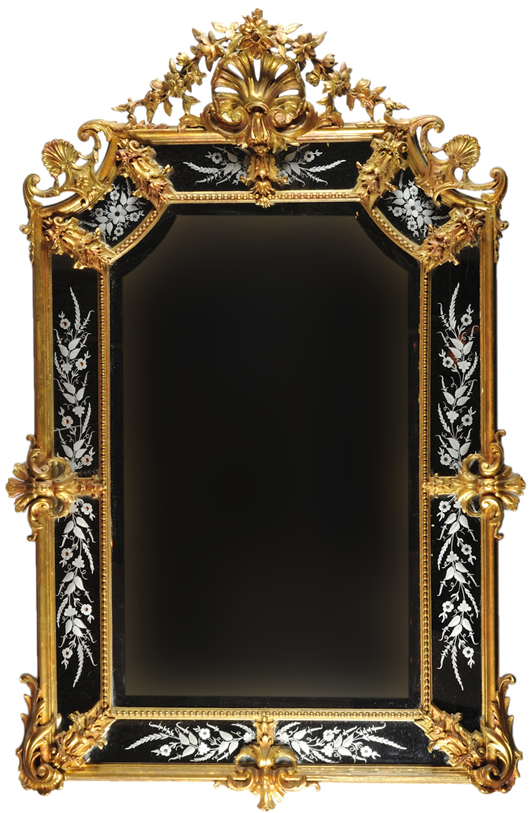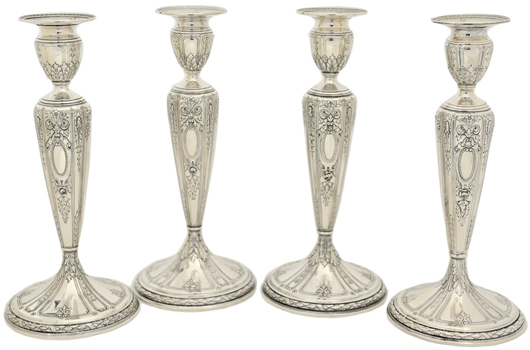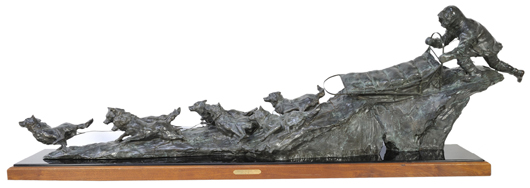Louis XVI giltwood pier mirror, 1920s, estimate: $4,000-$6,000. Image courtesy of Morton Kuehnert Auctioneers & Appraisers.
The Proctor estate includes furniture, sterling, crystal, toys, books, paintings and personal items to be auctioned beginning at 11 a.m Central on Sunday, Jan. 22, at 4901 Richmond Ave., Houston, TX 77027.
LiveAuctioneers.com will provide Internet live bidding.
Telephone calls can be scheduled by calling 713-827-7835.
Also featured in the auction are personal collections from family estates in Houston and Austin, including hunt and safari trophies, wildlife statuary and fine antique furniture and decorative art.
Judge Frederick C. “F.C.” Proctor, 1866-1935, general counsel for the Gulf Oil Companies from 1905-1919, was a prominent figure in the early days of oil development in Texas, Oklahoma and Louisiana. He was a prominent South Texas lawyer who practiced in Victoria and Cuero before becoming general counsel of the Gulf Oil Companies in 1905. Proctor and his wife Lucy Wofford moved to Houston in 1916 when Gulf transferred its headquarters from Beaumont.
Procter is credited in creating much of the comprehensive law relating to oil and gas. The family history is impressive. He was the son of David Cogswell Proctor, 1835-1908, an early pioneer to Texas from Shelby County, Ky., who was educated at Yale (master’s) and Harvard (jurisprudence), and served in the Confederate calvary as a colonel during the Civil War.
Over the years, David Cogswell Proctor was known as a man of “unimpeachable character” and when he died he was the dean of the Cuero Bar Association. As his practice evolved with various partners, the foundation of that practice has endured and is now the oldest existing law firm in Texas, located in Victoria.
Judge Proctor’s son was David C. Proctor Sr., 1890-1950, and he too was an attorney, receiving his undergraduate degree at Cornell University in Ithaca, N.Y., and his law degree from the University of Texas in Austin. David and his first wife, Hildegard Haggarty, married in 1912, living for a while in Ypsilanti, Mich., and then returned to Houston to care for his father, who died in 1935.
Judge Proctor and his wife built their final home during 1926-1928 at 2950 Lazy Lane, next door to Houston philanthropist Ima Hogg, whose home was Bayou Bend. The Proctor home was built by distinguished Houston architect Birdsall P. Briscoe. According to Stephen Fox, a Houston architectural historian, the two homes shared a driveway. The Proctor House site contained the Clock Garden, planned by the Kansas City landscape architects Hare & Hare and was the oldest designed landscape in River Oaks. The home was later bought by Mike and Alice Hogg, Ima’s brother, and was dubbed “Dogwoods.”
The judge was a friend of Gov. James S. Hogg, the father of Will, Ima, and Mike Hogg. It is said that he built the house on Lazy Lane to support the Hoggs’ efforts to develop River Oaks and especially Homewoods, the most elite subdivision within River Oaks. John F. Staub, the architect who designed Bayou Bend, told his biographer Howard Barnstone that he and Briscoe were asked by both the Hogg siblings and Judge and Mrs. Proctor to collaborate on the designs of their adjoining houses. The two architects agreed that Briscoe would design the Proctor House and Staub would design Bayou Bend. Dogwood was demolished in 2005, much to the dismay of River Oaks residents and Houston historians, to make way for construction of a new home on the Lazy Lane site.
ADDITIONAL LOTS OF NOTE
Louis XVI giltwood pier mirror, 1920s, estimate: $4,000-$6,000. Image courtesy of Morton Kuehnert Auctioneers & Appraisers. A set of four Gorham sterling silver candlesticks, early 20th century, monogrammed ‘FCP’ in an oval cartouche for Frederick C. Proctor, estimate: $3,500-$6,500. Image courtesy of Morton Kuehnert Auctioneers & Appraisers. Bronze sculpture ‘Crossing the Divide,’ signed ‘S. Sander, 86, copyright,’ number 6 of 25, estimate: $4,000-$6,000. Image courtesy of Morton Kuehnert Auctioneers & Appraisers. Fourteen-karat heavy link gold charm bracelet, estimate: $2,500-$4,500. Image courtesy of Morton Kuehnert Auctioneers & Appraisers. F. Ballesio (Italian, 1852-1943), ‘A Musical Rehearsal,’ watercolor, fair condition, estimate: $3,000-$5,000. Image courtesy of Morton Kuehnert Auctioneers & Appraisers.





